Is Mold in a Window Air Conditioner Dangerous?
If you’ve noticed a musty smell or visible mold in your window air conditioner, it’s time to clean it. How to clean a window air conditioner mold is a common question for many homeowners looking to maintain indoor air quality. Mold can build up in your AC unit due to moisture, but with the right steps, you can eliminate it and keep your unit running smoothly. This guide will walk you through easy and effective steps to remove mold and prevent future growth in your window air conditioner.
Potential Health Risks Caused by Mold Exposure
Exposure to mold in a window air conditioner can lead to several health issues, especially for individuals who are sensitive to allergens or have existing respiratory conditions. Some of the most common health risks include:
- Respiratory Problems
Mold spores can easily become airborne when disturbed. Inhalation of these spores can trigger allergic reactions, asthma attacks, or even infections in some cases. Common symptoms include coughing, wheezing, and shortness of breath. - Skin Irritation
Direct contact with mold spores can cause skin rashes, redness, or itching. If the mold is allowed to grow unchecked, skin irritation can become more severe. - Sinus and Nasal Issues
Mold exposure can irritate the sinus passages, leading to congestion, runny nose, sneezing, or headaches. This is particularly problematic for people with sinus sensitivities. - Worsening of Asthma
People who suffer from asthma may experience more frequent attacks, including chest tightness and difficulty breathing, due to mold exposure in the air conditioner. - Weakened Immune System
Those with compromised immune systems, such as individuals undergoing cancer treatment or taking immune-suppressing medications, are at a higher risk of mold-related health issues. Even small amounts of mold can cause serious infections or complications.
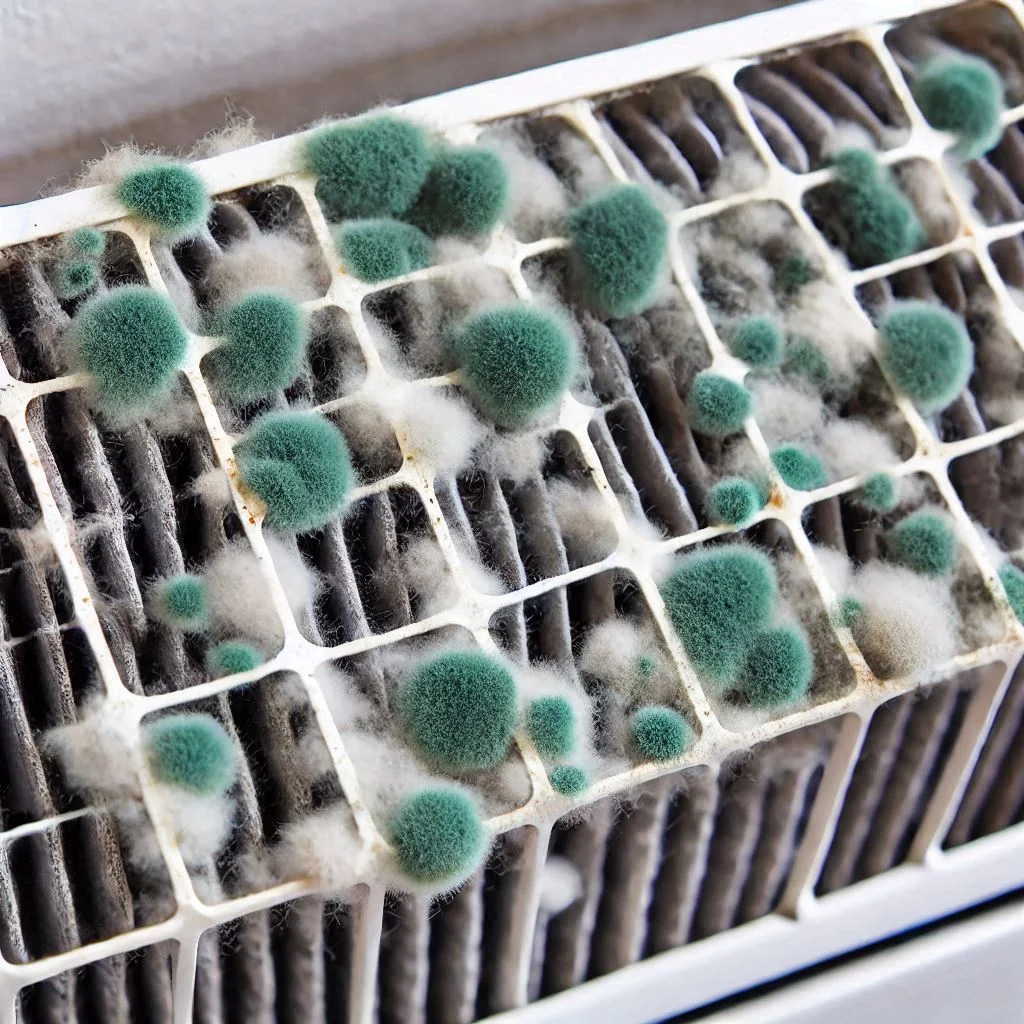
Signs and Symptoms of Mold-Related Issues
The sooner you identify mold-related issues, the quicker you can take action to eliminate it. Recognizing the signs of mold growth in your window air conditioner is essential for preventing long-term health problems. Here are some of the most common symptoms that may indicate the presence of mold:
- Musty Odor
A strong, musty smell coming from the air conditioner is often the first indication of mold. If your AC has a moldy smell every time you turn it on, it’s likely that mold is thriving in the unit. - Frequent Allergic Reactions
If you notice frequent sneezing, a runny nose, or itchy eyes whenever the air conditioner is running, mold could be the culprit. People with allergies may experience aggravated symptoms when exposed to mold spores. - Persistent Coughing or Throat Irritation
Prolonged coughing or a sore throat, especially when the AC is running, can indicate mold spores are circulating through the air. Mold exposure can inflame the throat and lead to discomfort. - Visible Mold Growth
In some cases, you may be able to see mold growing on the filters, coils, or other parts of the window AC. Mold often appears as black, green, or white patches and can spread quickly if not addressed promptly. - Increased Asthma Symptoms
For asthma sufferers, mold exposure can make symptoms worse. If you or someone in your household is experiencing more frequent asthma attacks or other breathing difficulties while the air conditioner is running, mold could be present.
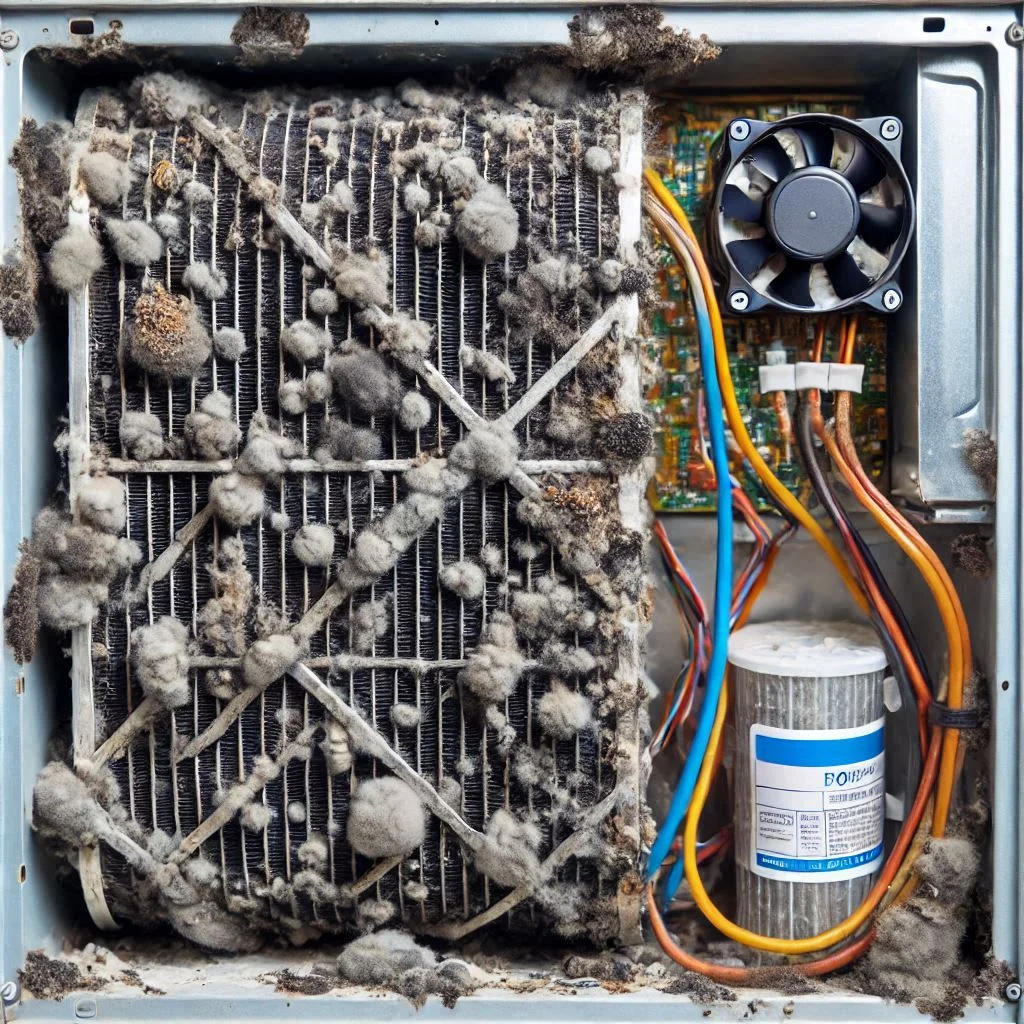
- Dark or Damp Areas Around the AC
Mold thrives in moist environments. If you notice areas around your window air conditioner that appear damp or darkened, this could indicate a hidden mold problem. These areas are prime spots for mold to grow, especially if there is insufficient airflow. - Unexplained Fatigue or Headaches
Continuous exposure to mold can lead to chronic fatigue and headaches. These symptoms may be subtle at first but can worsen over time, particularly if the mold remains untreated.
By addressing mold growth in your window air conditioner early, you can prevent it from becoming a serious health risk. If you notice any of the symptoms mentioned above, it’s crucial to clean your AC unit immediately and seek professional help if necessary.
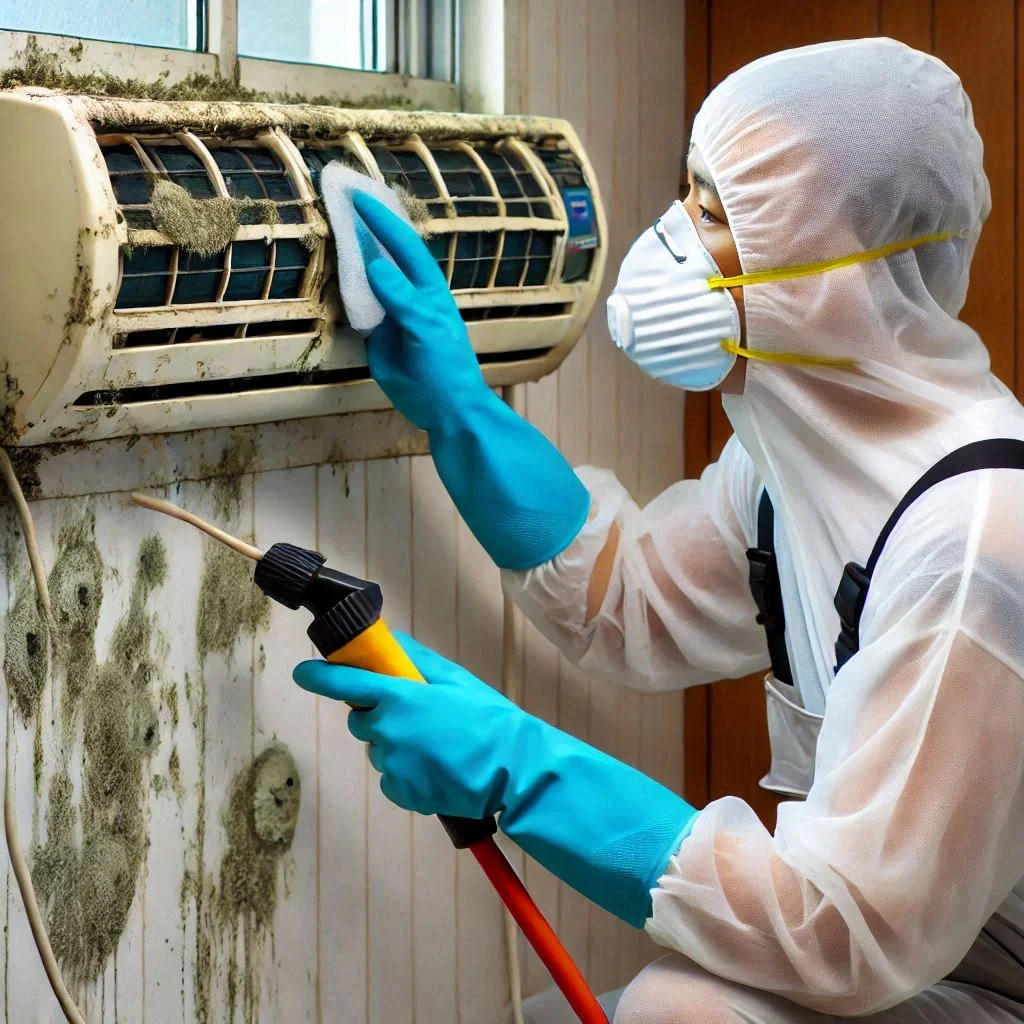
What Causes Mold Growth in Window Air Conditioners?
Mold growth in window air conditioners is a common problem that can arise due to several factors. Understanding these causes is crucial for both preventing mold and addressing it effectively once it appears. In this section, we’ll explore the environmental factors that encourage mold growth and highlight the common causes, such as moisture accumulation and poor ventilation, which contribute to this issue.
Understanding the Environment That Promotes Mold Growth in AC Units
Window air conditioners are designed to cool and circulate air, but the environment inside the unit can create an ideal breeding ground for mold and mildew. These small, often unnoticed fungi thrive in damp, dark, and warm conditions—exactly what an air conditioning system can offer. When humidity levels are high or when the air conditioner is not used properly, moisture can build up inside the unit, fostering mold growth. Here’s how the environment in a window AC unit promotes mold:
- Moisture Accumulation
When warm air is drawn into the air conditioner and cooled, condensation occurs. This moisture typically drains out through the unit’s drainage system, but if the system is clogged or if the humidity level is too high, excess moisture can collect inside. When moisture lingers, it creates an ideal environment for mold spores to settle and multiply on internal components such as the coils, filters, and other parts of the AC unit. - Temperature Fluctuations
Air conditioners often operate in environments where temperatures fluctuate between cool and warm. This causes condensation inside the unit when warm air comes into contact with cooler surfaces. Over time, repeated cycles of condensation and drying out can contribute to mold growth if the moisture isn’t properly removed. - Lack of Proper Airflow
Inadequate airflow inside the air conditioner can trap moisture, especially in the cooling coils and filter areas. If the unit is installed improperly or if the filter is dirty, airflow can be reduced, leading to trapped moisture that can encourage mold growth.
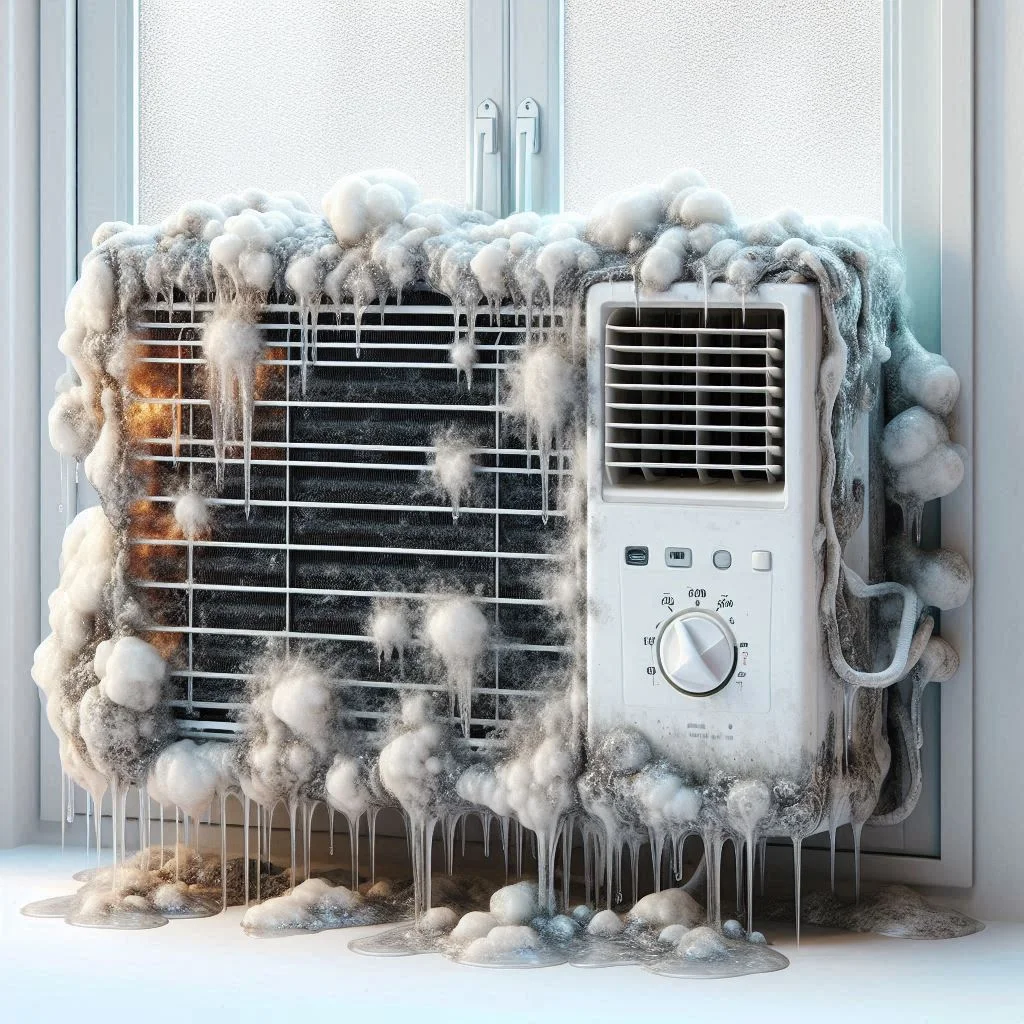
Common Causes of Mold in Window Air Conditioners
Now that we’ve explored the environment, let’s look at the most common causes of mold growth in window AC units. These causes are typically preventable with proper maintenance and attention to the following factors:
- Excessive Humidity
High humidity is one of the main contributors to mold growth in air conditioners. In areas with high outdoor humidity or during the summer months, the excess moisture in the air can easily enter the AC unit and settle on internal parts. If the air conditioner cannot remove enough moisture from the air, it will accumulate inside the unit, encouraging mold growth.- Tip: Use a dehumidifier in conjunction with your air conditioner to reduce moisture in the air, especially during the hotter months.
- Clogged Drain Lines
Air conditioners are designed to remove moisture from the air and channel it outside through drainage pipes. Over time, these drainage lines can become clogged with dirt, dust, and debris. When the water has no place to go, it can pool inside the unit, creating the perfect conditions for mold to develop. - Dirty Filters
A clogged or dirty filter not only reduces the efficiency of your air conditioner but can also contribute to mold growth. Filters that aren’t cleaned or replaced regularly can trap dirt, dust, and moisture, which may lead to mold forming in the AC unit. A clean filter is essential for maintaining healthy airflow and preventing mold.
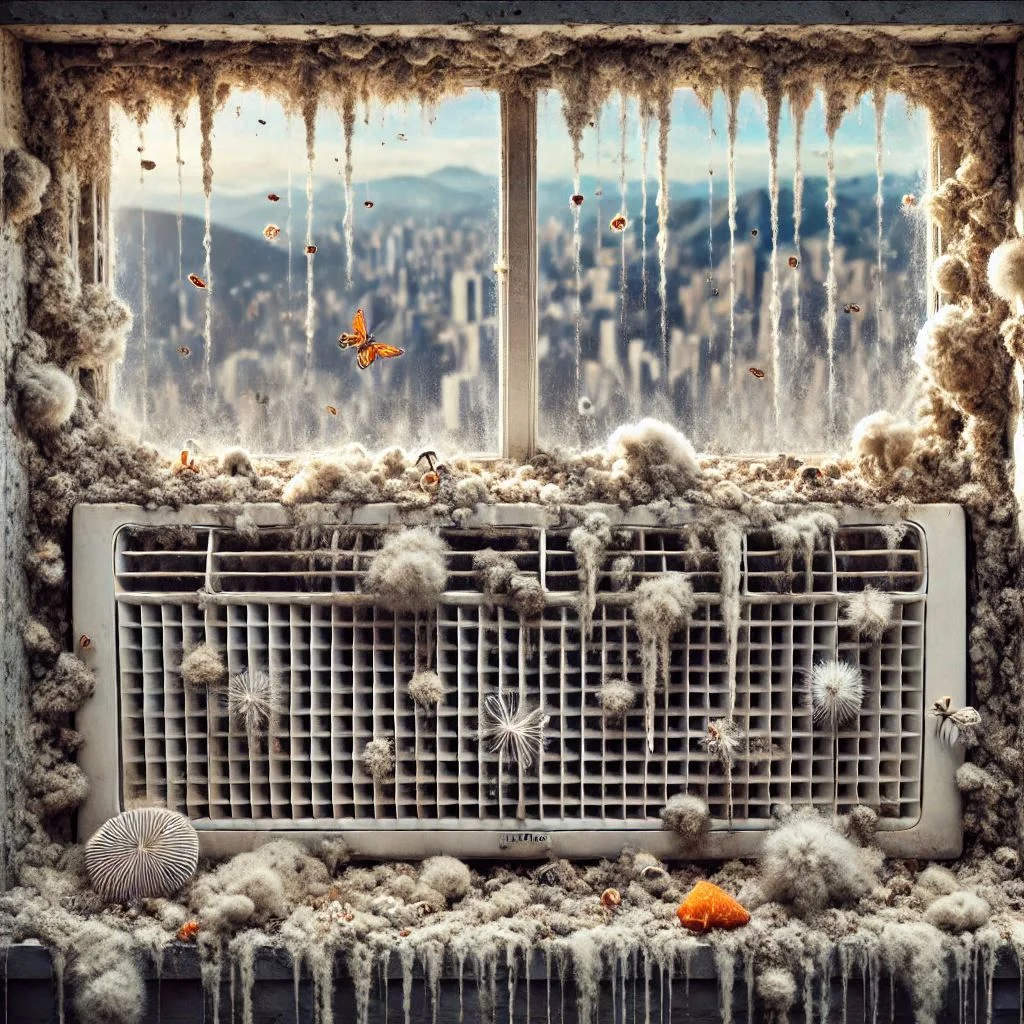
Infrequent Cleaning and Maintenance
Many people neglect to clean their window air conditioners regularly, which can lead to a buildup of dust, dirt, and moisture inside the unit. This lack of maintenance provides a perfect environment for mold to take root. Regular cleaning is essential to remove dust, mold spores, and other debris before they have a chance to multiply.
- Improper Installation
If a window air conditioner is not installed correctly, it can cause drainage issues or improper airflow, both of which contribute to mold growth. Ensuring that your AC is level and properly sealed can prevent water from pooling inside the unit and reduce the chances of mold formation.
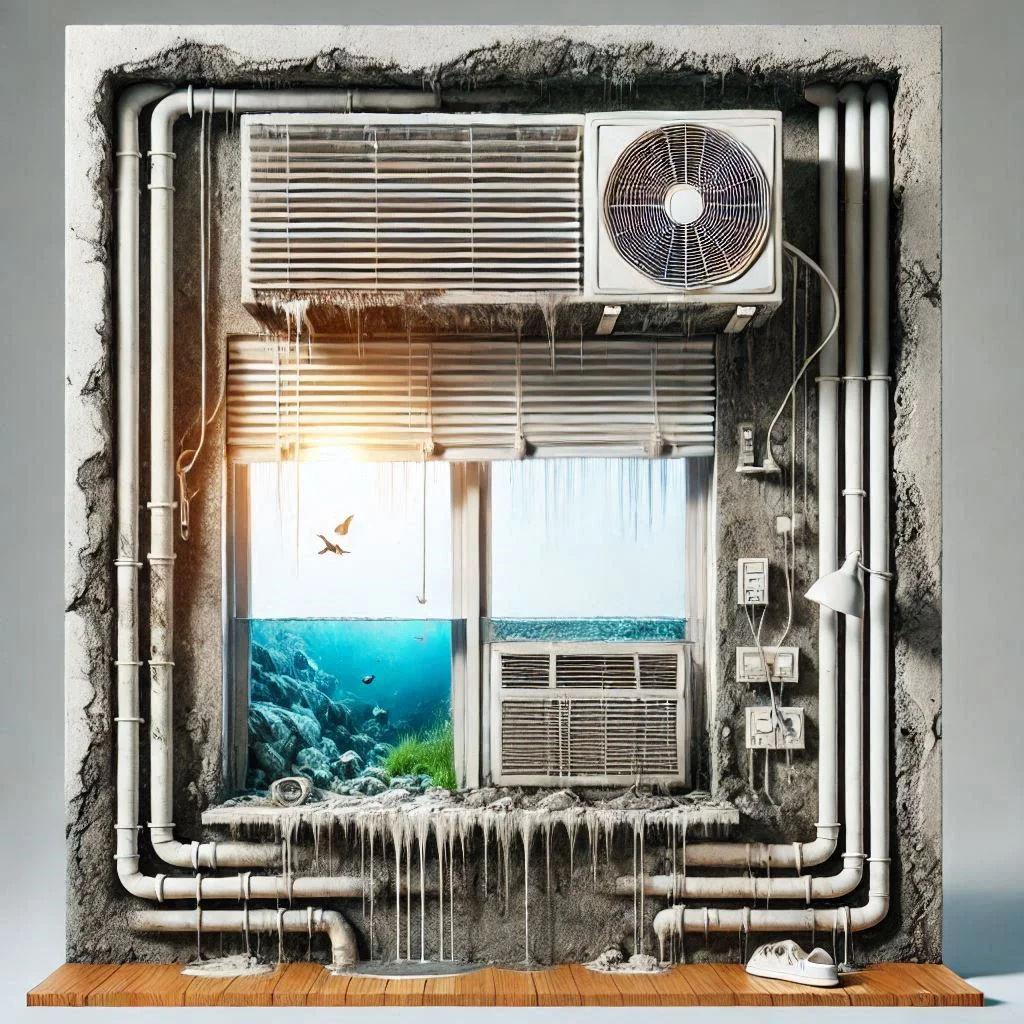
Essential Supplies to Clean Mold from a Window AC
Cleaning mold from a window air conditioner requires the right tools, cleaning materials, and safety gear to ensure both effective mold removal and personal protection. Having the correct supplies on hand is crucial to prevent further contamination and to maintain the health of both your air conditioner and the occupants of your home. In this section, we will outline the essential tools and materials you need for cleaning mold from your AC unit, as well as the safety equipment required to protect yourself during the cleaning process.
Tools and Cleaning Materials Required
- Screwdriver
A screwdriver is needed to open the window air conditioner unit and remove the faceplate and filter. This tool will allow you to access internal parts where mold may be hiding. - Vacuum Cleaner (with Hose Attachment)
A vacuum cleaner equipped with a hose attachment is an essential tool for removing dust, dirt, and loose debris from your air conditioner. Vacuuming can also help eliminate any dry mold spores before they are disturbed and become airborne. - Cleaning Brushes (Soft-Bristle)
Soft-bristle brushes are ideal for scrubbing the air conditioner’s cooling coils, vents, and other delicate components. Using a soft brush prevents damage while removing mold and dirt buildup. A handheld brush or a toothbrush can be particularly useful for detailed cleaning. - Mold and Mildew Cleaner or Vinegar Solution
A powerful cleaner specifically designed for mold and mildew removal is essential. If you prefer natural alternatives, a mixture of white vinegar and water (1:1 ratio) is an effective and safe mold cleaner. These cleaners help kill mold spores and prevent further growth. - Disinfectant Spray
After scrubbing and cleaning the visible mold, it’s important to disinfect the surfaces to ensure that all mold spores are killed. A disinfectant spray with anti-fungal properties will help prevent the return of mold in the future. - Microfiber Cloths or Rags
Microfiber cloths or soft rags are excellent for wiping down the surfaces after mold cleaning. They are absorbent and won’t leave lint behind. Use these cloths to dry off cleaned areas and remove any remaining moisture. - Air Conditioner Coil Cleaner
If mold is present on the coils, using an air conditioner coil cleaner can help. These cleaners are designed to remove buildup and mold from the delicate cooling fins and coils without causing damage. - Spray Bottle (for Vinegar Solution)
A spray bottle is useful for applying the vinegar solution or cleaner to the mold-infested areas. It helps you evenly distribute the solution and control the amount applied to the surface.
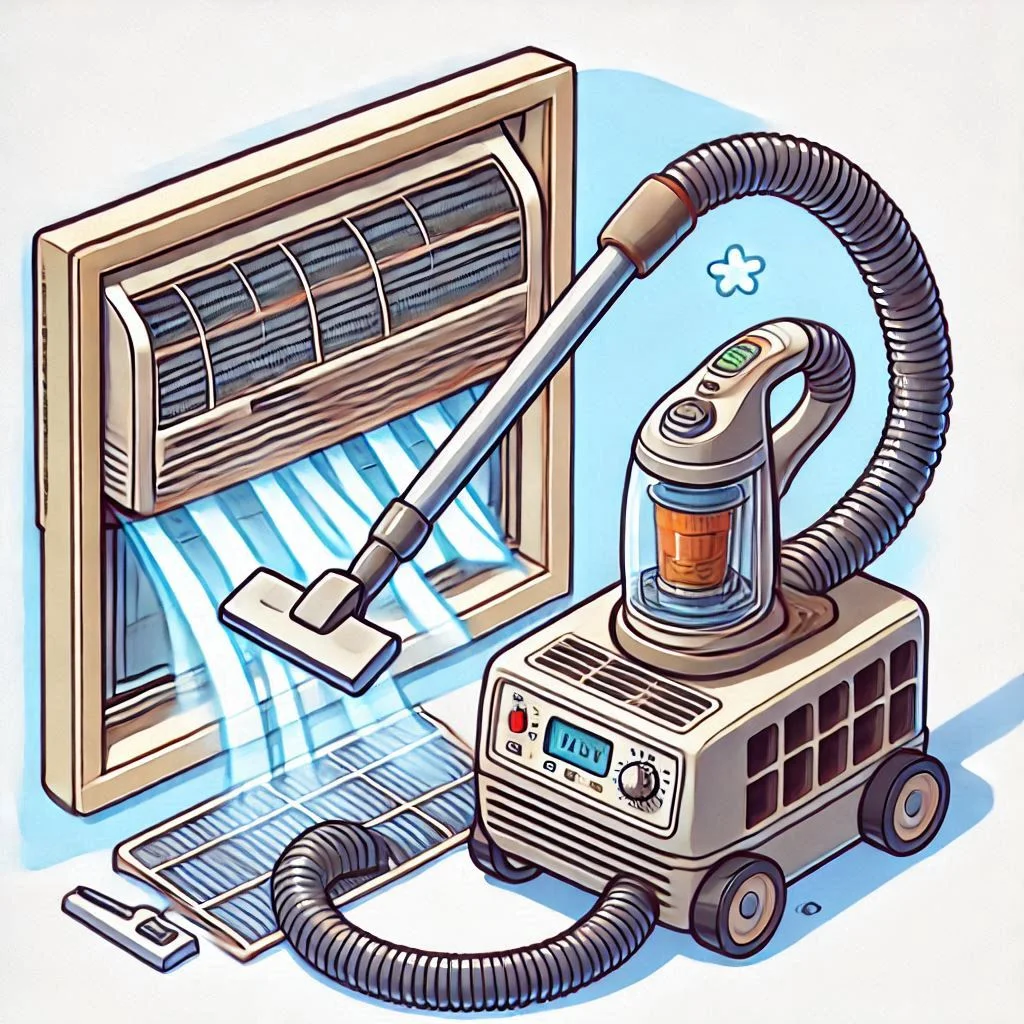
Safety Gear Needed for Mold Removal
Cleaning mold in a window air conditioner is a job that requires proper safety precautions. Mold spores can be harmful to your health, especially when inhaled or touched. Therefore, wearing the appropriate safety gear is essential to avoid exposure to these harmful particles. Here’s a list of the safety equipment you’ll need:
- Protective Gloves
Mold exposure can irritate your skin, so it’s crucial to wear protective gloves. Choose durable, chemical-resistant gloves, such as rubber or nitrile gloves, to prevent direct contact with mold and cleaning chemicals. - Face Mask or Respirator
A face mask, or even better, a NIOSH-approved respirator with a P100 filter, will help protect your lungs from inhaling mold spores during the cleaning process. This is especially important if you have asthma or other respiratory issues. - Safety Goggles
Mold cleaning can sometimes result in cleaning products splashing or mold particles becoming airborne. Wearing safety goggles will protect your eyes from irritation and infection caused by exposure to mold and cleaning chemicals. - Long Sleeves and Pants
Wearing long sleeves and pants helps protect your skin from coming into contact with mold or cleaning solutions. This is particularly important if you have sensitive skin or are dealing with an extensive mold problem.
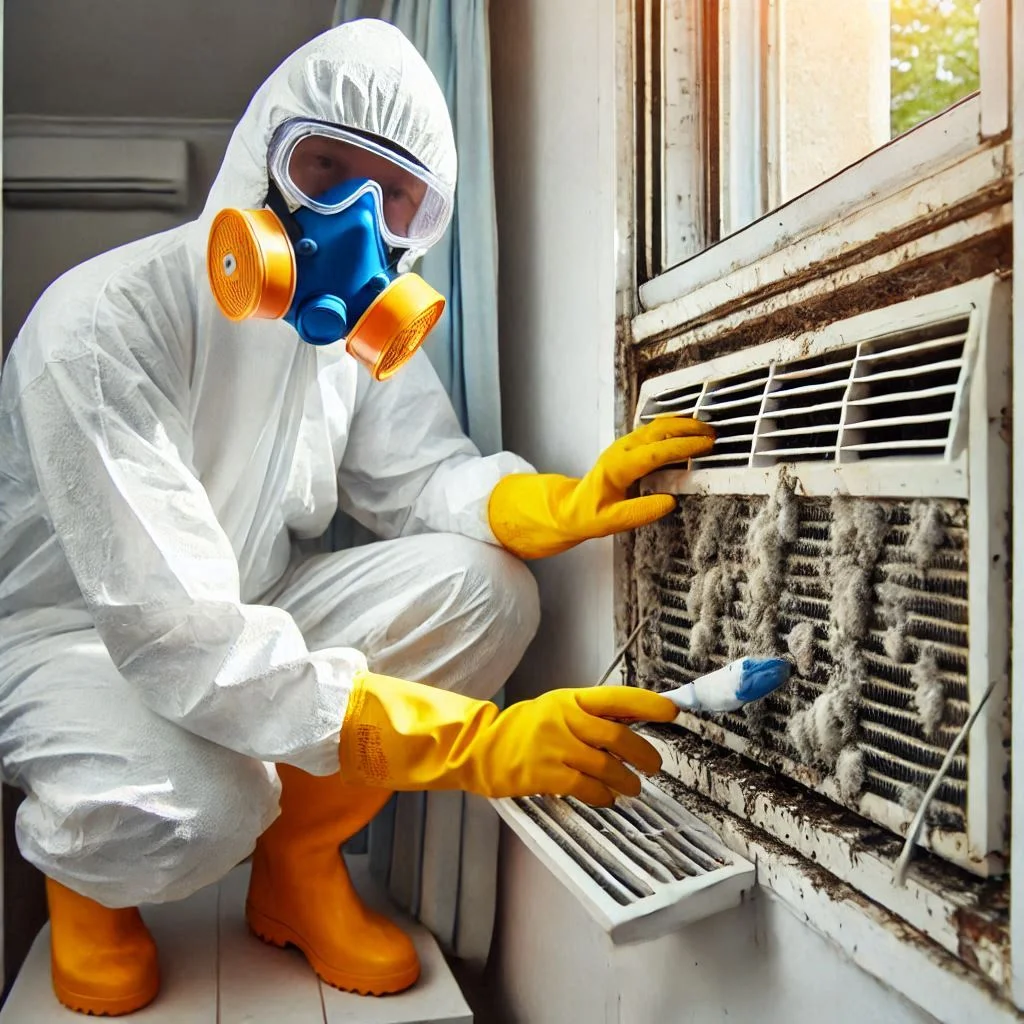
Step-by-Step Guide to Removing Mold from Your Window AC
Mold removal from a window air conditioner is a crucial task to ensure your unit operates efficiently and that the air you breathe is clean. If you’ve noticed signs of mold, it’s important to act quickly and use the proper cleaning techniques to remove it effectively. This step-by-step guide will walk you through the process of safely cleaning mold from your window AC unit, ensuring both its functionality and the health of your home.
1. Turn Off and Unplug the Unit for Safety
Before starting any cleaning or mold removal task, safety is the top priority. Always turn off and unplug your window air conditioner. This eliminates the risk of electrical shock and ensures that no power is running through the unit while you are working on it. Additionally, make sure the area around the air conditioner is dry to avoid any electrical hazards.
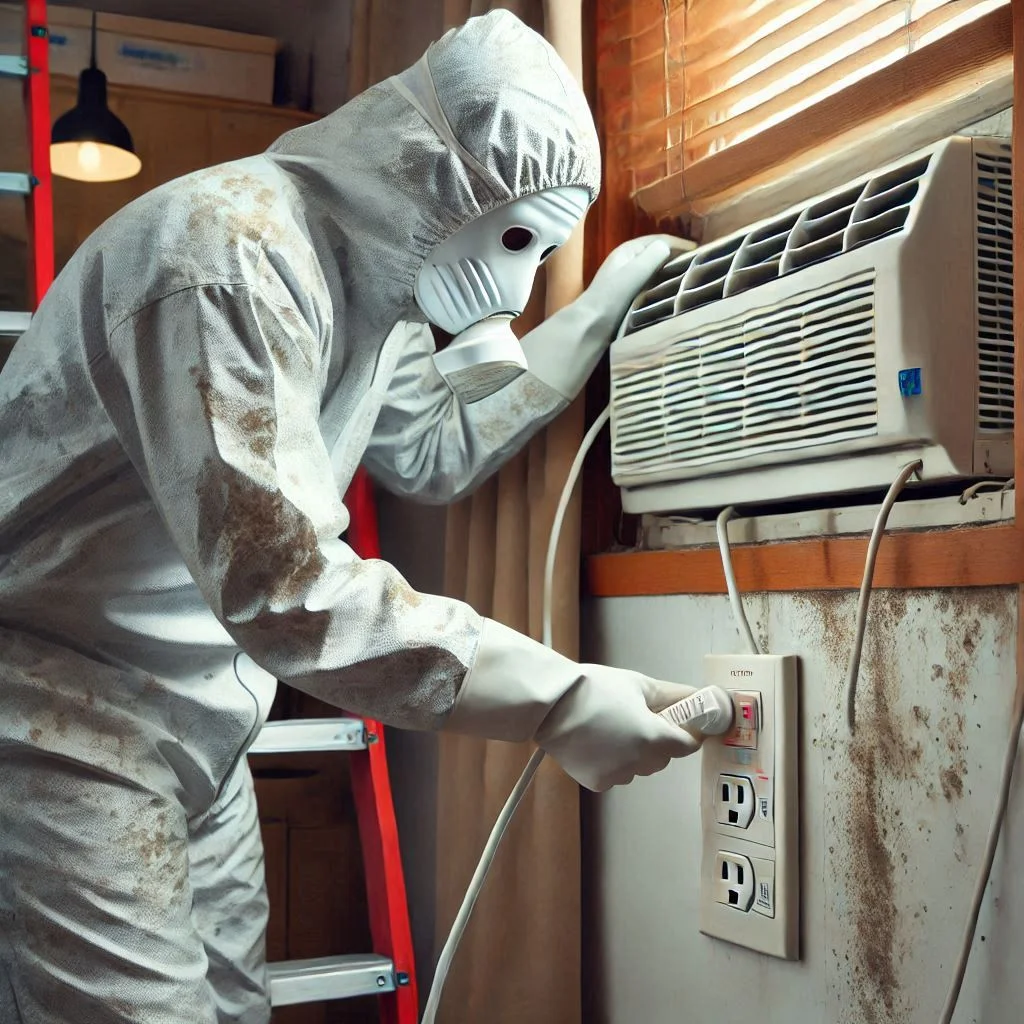
2. Detach and Clean the Filter
The filter of your window air conditioner is one of the first places mold and dust accumulate. To start the cleaning process, remove the air filter by carefully detaching it from the unit. If the filter is heavily soiled, it may be best to replace it entirely. However, if it’s still in good condition, clean it thoroughly using the following steps:
- Rinse the filter under lukewarm water to remove dust and dirt. If necessary, use mild soap or a specialized air conditioner filter cleaner to clean it.
- Scrub gently with a soft brush to remove any mold or mildew that may be stuck to the filter.
- Allow the filter to dry completely before reinstalling it.
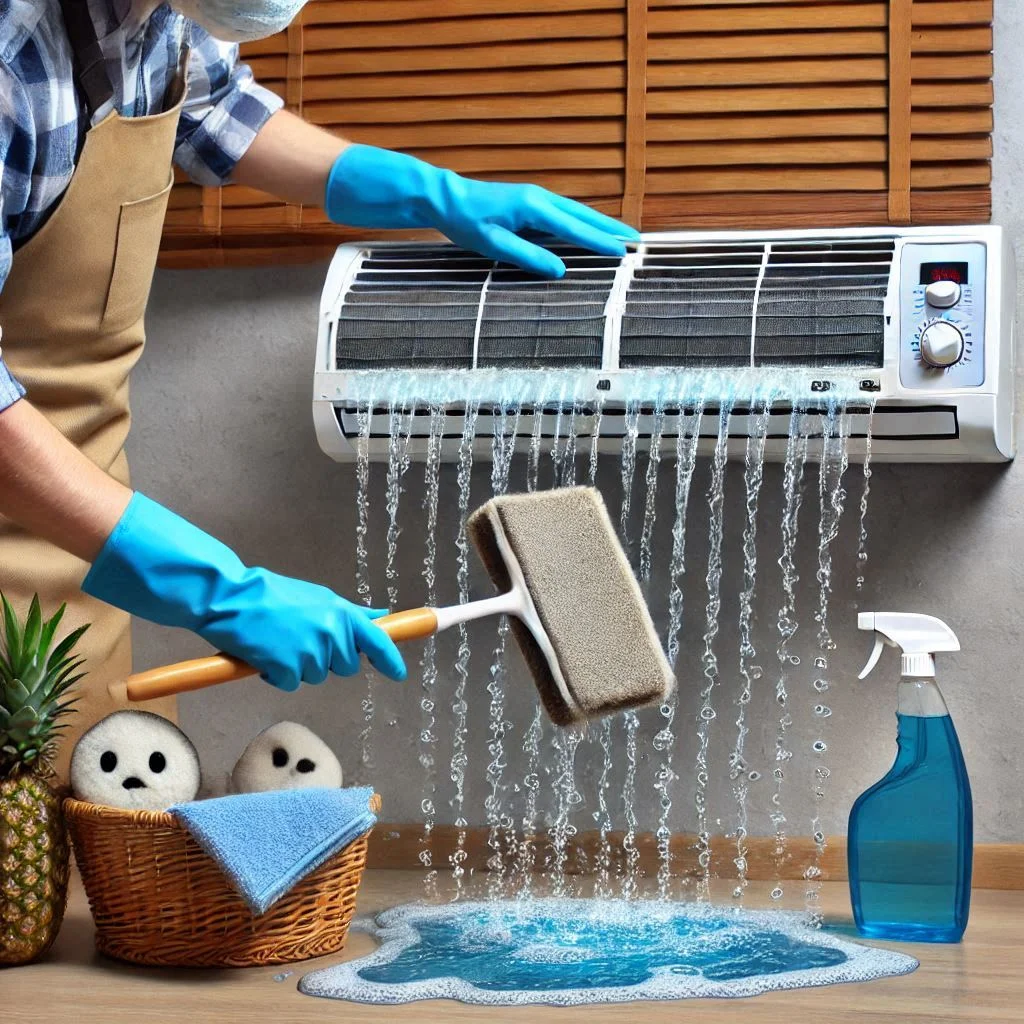
3. Vacuum the Interior Components
Once the filter is cleaned or replaced, it’s time to move on to the internal components of the air conditioner. Vacuum the interior of the AC unit using a hose attachment. This step is essential for removing any loose dirt, dust, and mold spores that may have accumulated inside. Pay special attention to the cooling coils, vents, and drainage areas, as these areas are often prime locations for mold buildup.
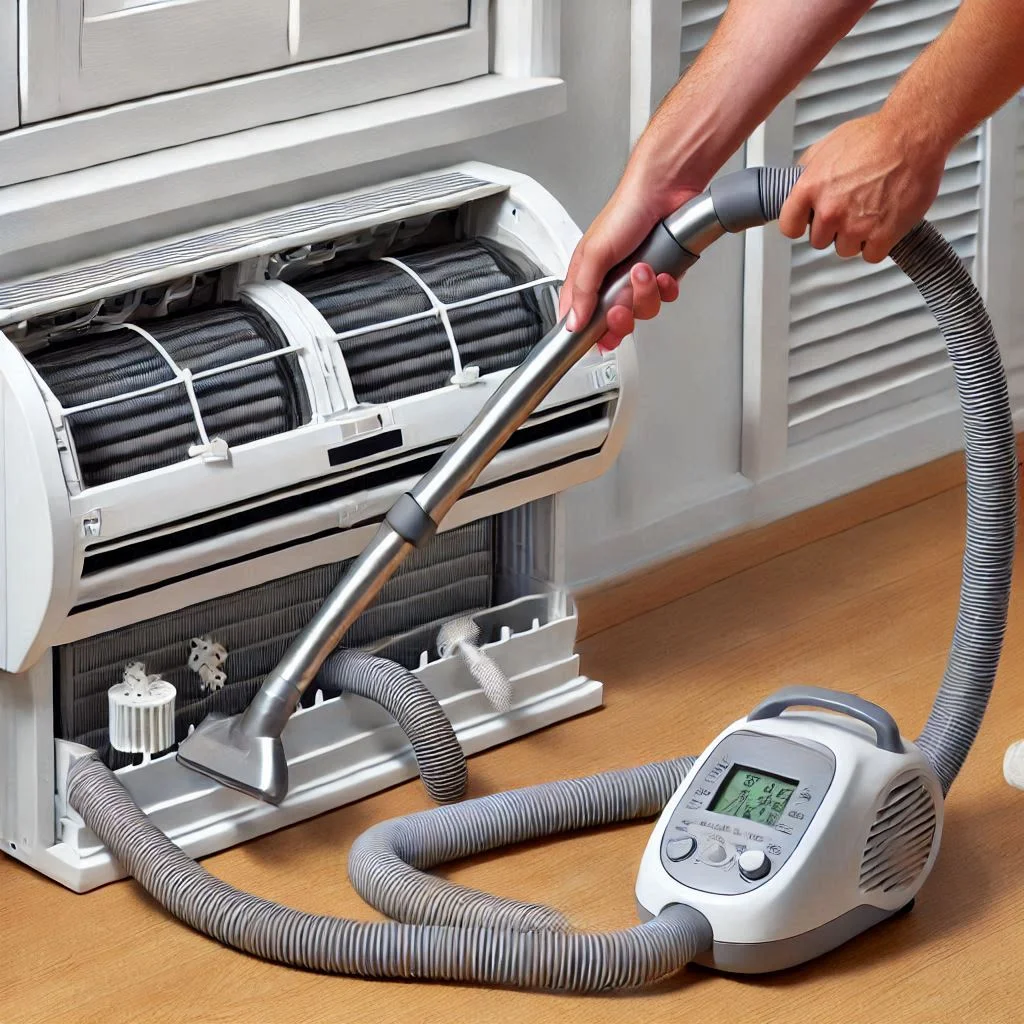
4. Clean the Coils and Straighten the Fins
After vacuuming the unit, it’s time to clean the cooling coils and straighten the fins. The coils are an essential part of the AC unit that help cool the air, and they can easily trap mold if not properly maintained. To clean the coils:
- Use a coil cleaner (or a vinegar and water solution) to spray down the coils and remove any visible mold or buildup.
- Gently scrub the coils using a soft brush to remove mold and mildew, making sure not to damage the delicate fins.
Next, straighten the fins using a fin comb or another appropriate tool to ensure proper airflow. Bent fins can obstruct airflow and decrease the efficiency of your air conditioner, making it harder to cool your space.
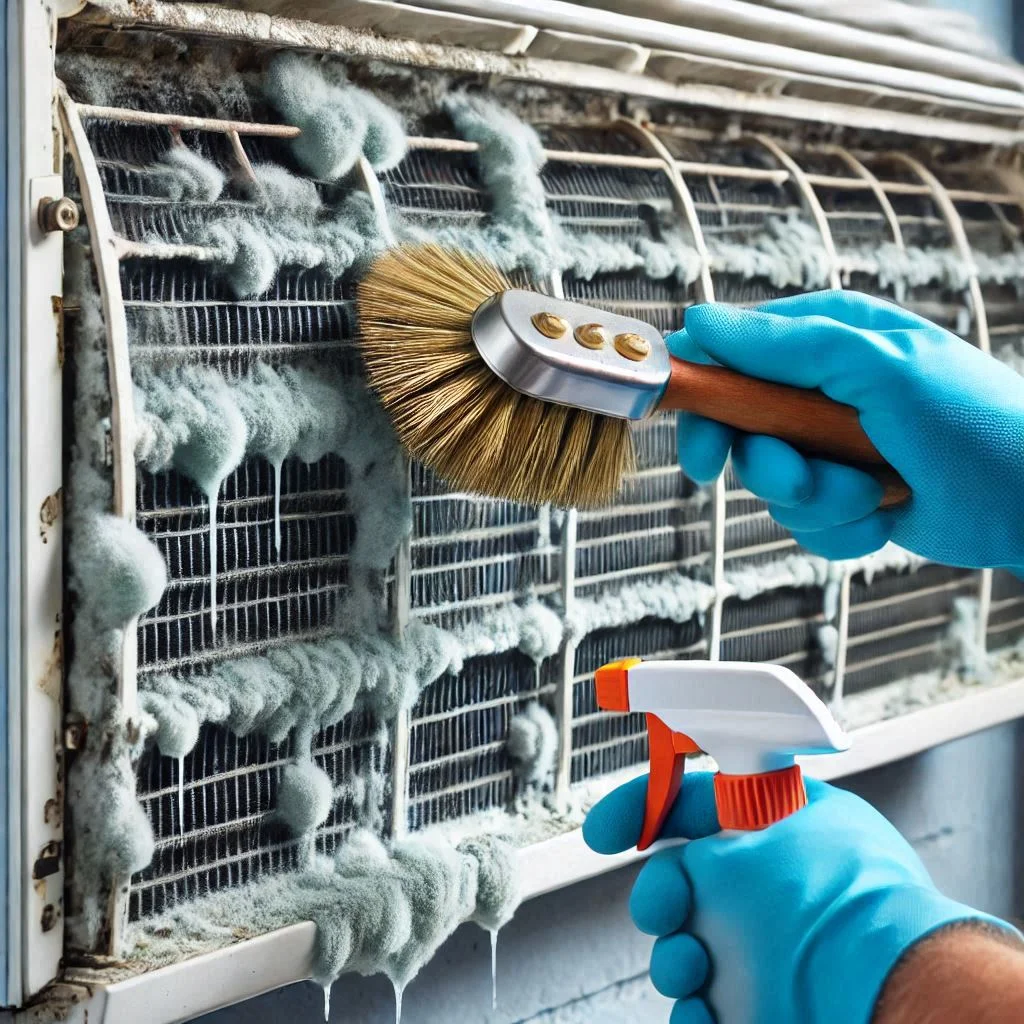
5. Allow the Unit to Air Dry Completely
After cleaning the filter, vacuuming the interior, and cleaning the coils, it’s crucial to let the window air conditioner air dry completely. Mold thrives in damp environments, so ensuring the unit is fully dry will prevent mold from returning. Leave the AC unit unplugged and open the vents to allow the moisture to evaporate. This drying process may take several hours, depending on the humidity and airflow in the room.
Once dry, reinstall the filter, and check the unit to ensure that it is functioning properly before turning it back on.

Tips to Prevent Mold from Growing in Your Window Air Conditioner
Mold growth in window air conditioners is a common issue that can negatively impact your air quality and the efficiency of your AC unit. However, with the right maintenance practices, you can prevent mold from taking root in the first place. In this section, we will discuss effective strategies for maintaining proper ventilation, minimizing moisture, and the importance of regular servicing and cleaning to keep your window AC mold-free.
1. Maintain Proper Ventilation
Proper ventilation is one of the most important factors in preventing mold growth in your window air conditioner. When the air conditioner is running, it generates moisture, and without adequate airflow, this moisture can accumulate and create an ideal environment for mold to thrive.
- Ensure adequate airflow by keeping the room ventilated and allowing air to circulate freely. Open windows periodically to allow fresh air to enter and reduce humidity.
- Use exhaust fans in areas with high humidity, such as kitchens and bathrooms, to help maintain air circulation and prevent moisture buildup.
- Position your window AC correctly. Make sure it’s installed at a slight tilt to allow for proper drainage of condensed water. If water collects inside the unit, it can lead to mold growth.
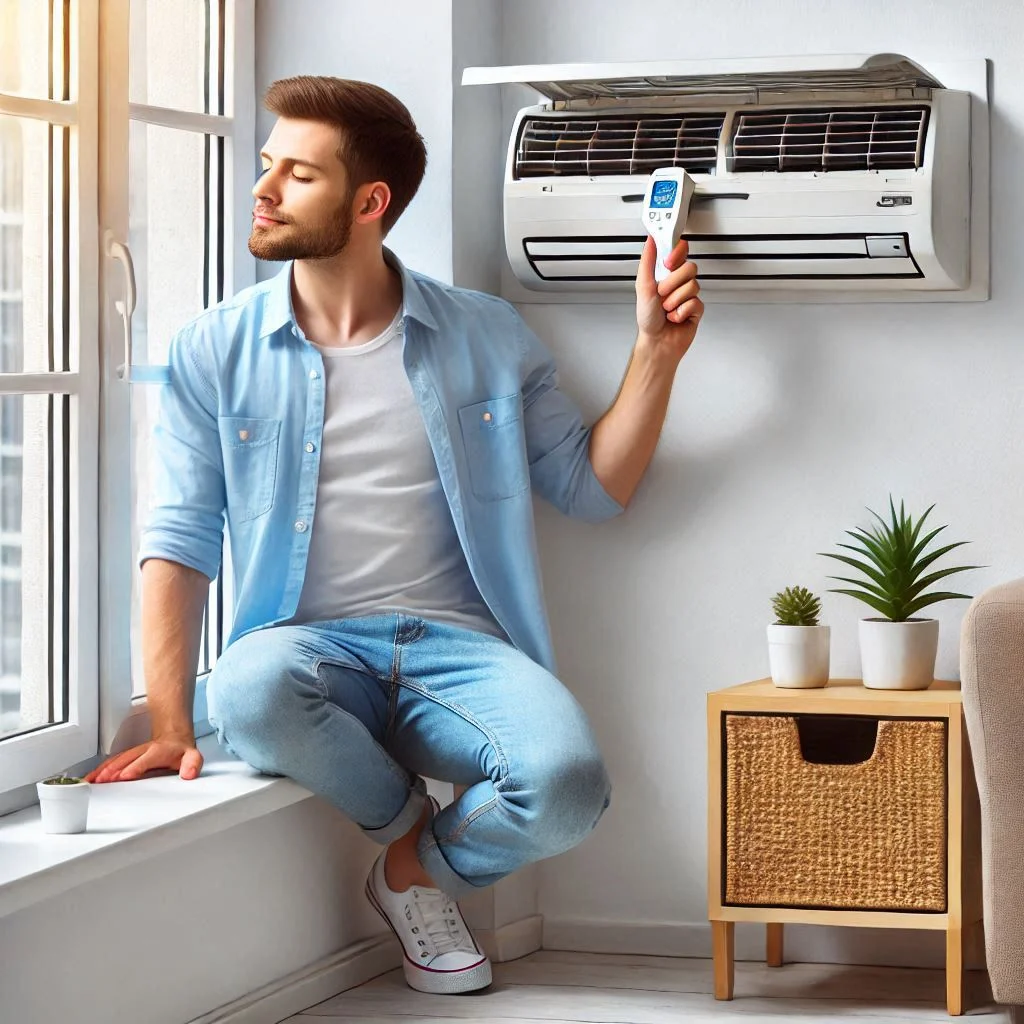
2. Minimize Moisture and Humidity
Mold thrives in environments with excessive moisture and humidity. Keeping the humidity levels in your home in check is crucial to preventing mold growth in your window AC unit.
- Use a dehumidifier in high-humidity areas to reduce the moisture in the air. A dehumidifier helps remove excess moisture, making it harder for mold to grow.
- Avoid running the AC in high humidity without proper ventilation. If the air conditioner is constantly running in a humid environment, it can trap moisture inside the unit, fostering mold growth.
- Fix any leaks around your window AC. Ensure that the unit is sealed properly to prevent rainwater or moisture from entering the AC unit.
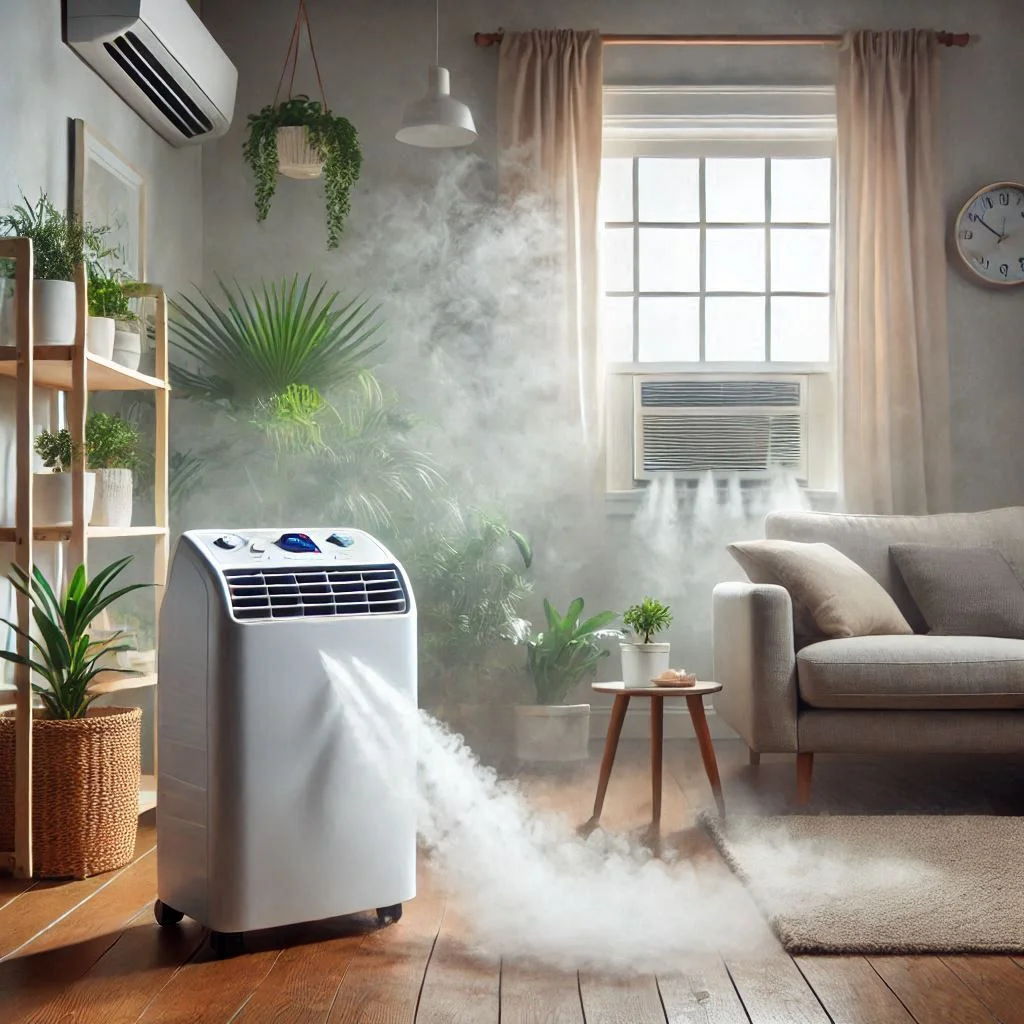
3. Importance of Regular Servicing and Cleaning
One of the best ways to prevent mold from taking hold in your window air conditioner is through regular servicing and cleaning. Keeping the unit well-maintained not only improves its efficiency but also ensures that it remains free from contaminants like mold, dirt, and dust.
- Clean the filter regularly. A dirty filter can trap moisture and mold spores, making it an ideal breeding ground for mold. Clean or replace the filter every 1-2 months, depending on usage.
- Schedule regular professional servicing. Having a professional HVAC technician inspect and clean your air conditioner once a year can help identify and address potential mold problems before they become serious.
- Wipe down the cooling coils. The coils in your AC unit are prone to moisture buildup. Regularly clean the coils using a soft brush and coil cleaner to remove any dirt or mold that may have formed.
- Dry out the unit after use. If you’re not using the AC for an extended period, leave the front panel open to allow the unit to dry out completely.
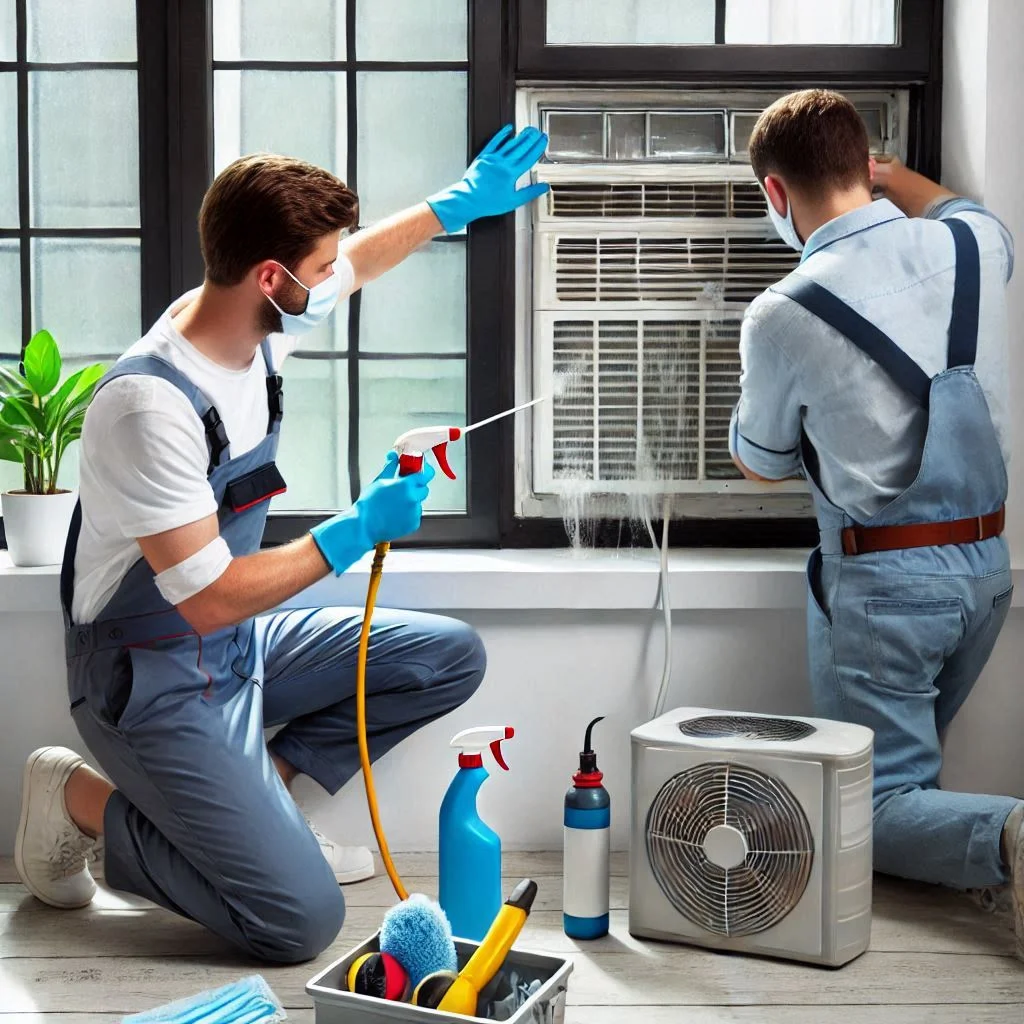
4. Install UV Light Purifiers in the AC Unit
To add an extra layer of protection against mold, consider installing a UV light purifier inside the air conditioner. UV lights have been proven to kill mold spores, bacteria, and viruses, ensuring that your air remains clean and safe to breathe.
- UV light installation can be done by a professional, or you can opt for portable UV light purifiers designed for window air conditioners.
- These lights work by breaking down the DNA of mold and other microorganisms, rendering them harmless.
Frequently Asked Questions (FAQs) on Cleaning Mold from Window Air Conditioners
Q1: Is it safe to use my window air conditioner if there is mold in it?
Mold in your window air conditioner can lead to poor air quality and potential health issues. Using an AC unit with mold can release mold spores into the air, which can cause respiratory problems, allergies, and other health concerns. It’s best to clean the mold from the AC unit before turning it on again to ensure that the air in your home remains safe and clean.
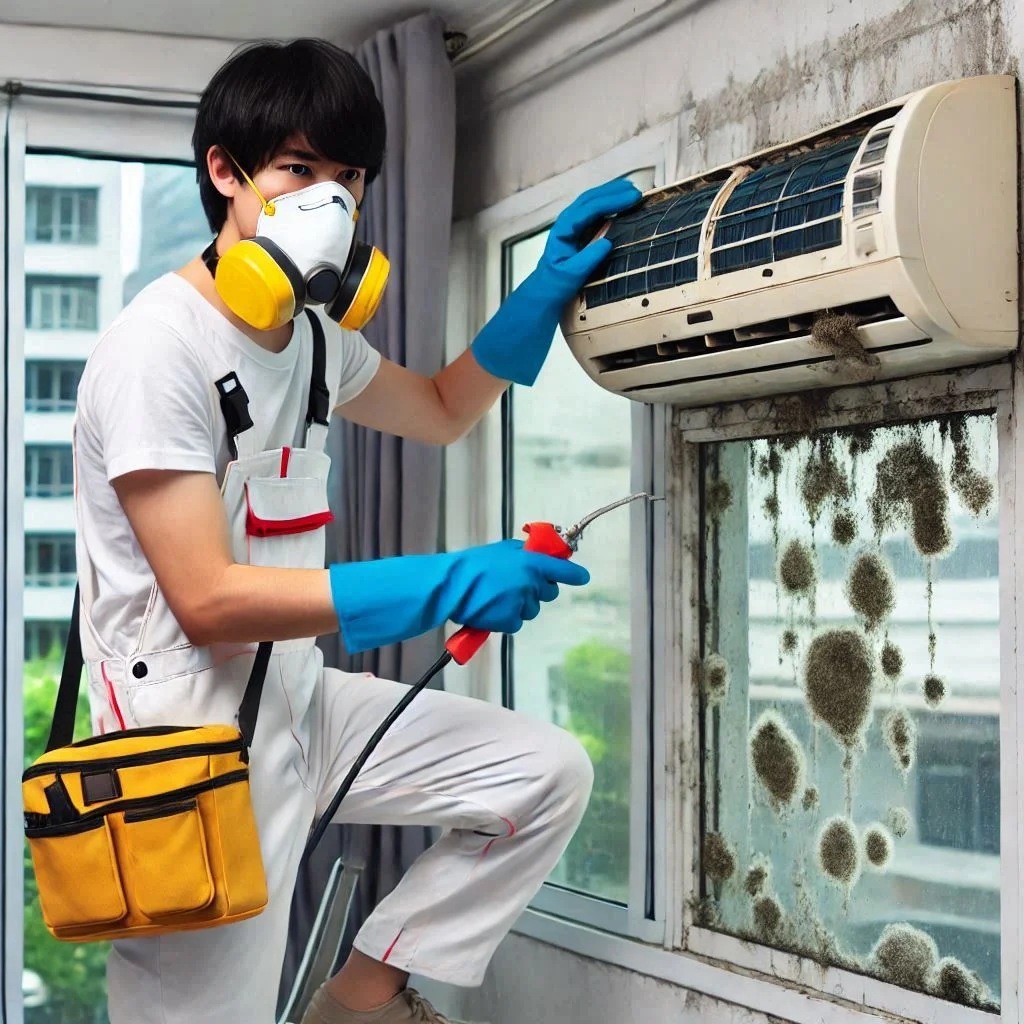
Q2: How often should I clean my window air conditioner to prevent mold buildup?
It’s recommended to clean your window air conditioner at least once every 1-2 months during the cooling season to prevent mold buildup. However, if you live in a humid environment or use your AC frequently, you may need to clean it more often. Additionally, the air filter should be checked and cleaned or replaced regularly, typically every month, to ensure optimal performance and to prevent mold growth.
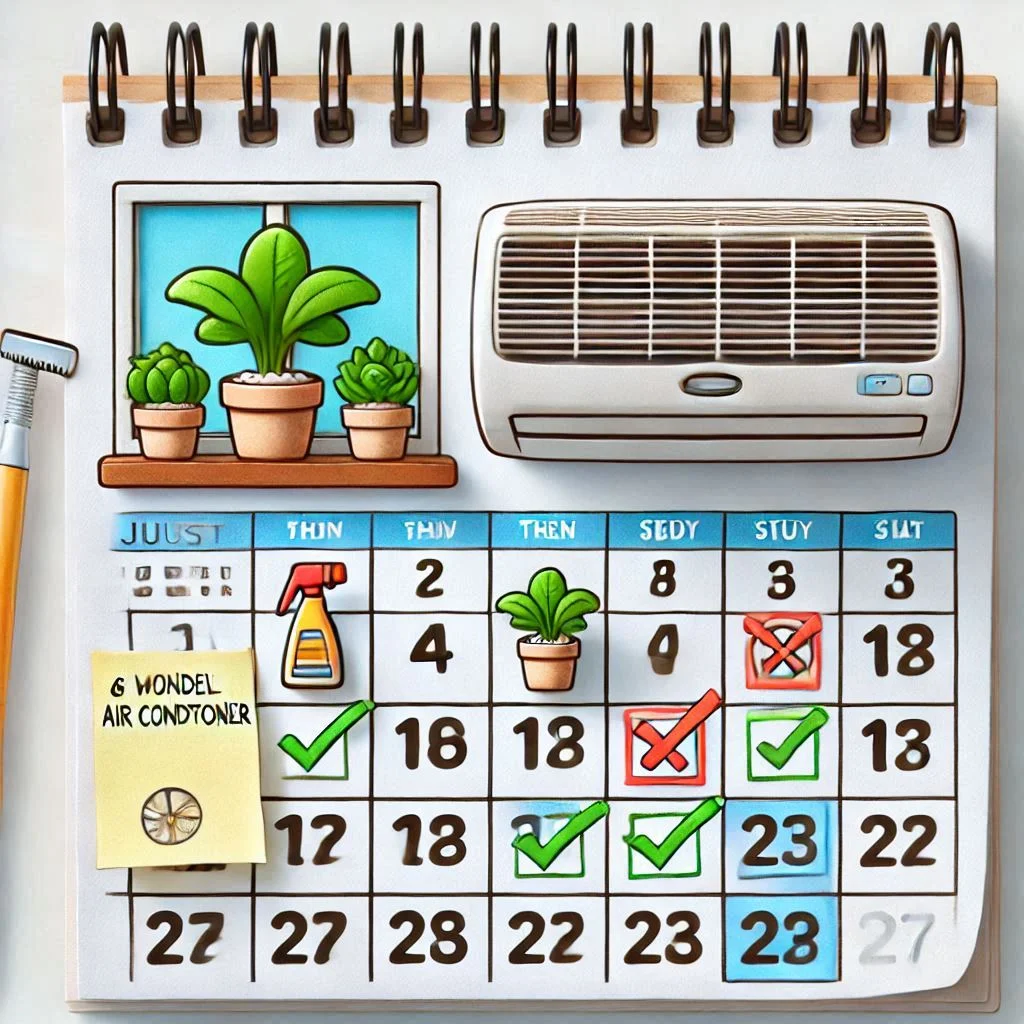
Q3: Can I use household cleaning products to remove mold from my window air conditioner?
Yes, you can use household products like vinegar, baking soda, and mild dish soap to clean mold from a window air conditioner. For tougher mold, a specialized mold remover or coil cleaner may be required. When using any cleaning product, always follow the instructions on the label and ensure the unit is properly dried after cleaning to prevent further mold growth.
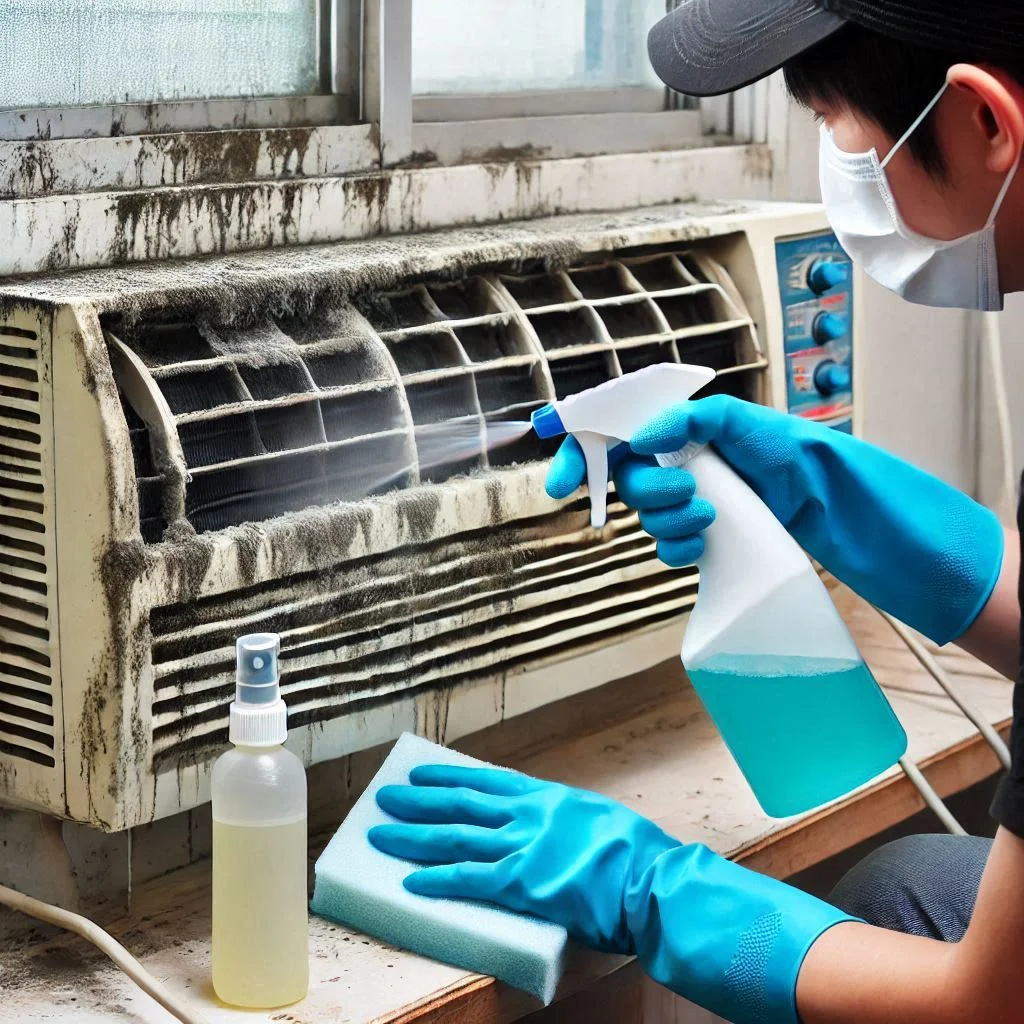
Q4: What should I do if mold keeps coming back in my window air conditioner?
If mold keeps returning in your window air conditioner despite regular cleaning, it’s likely due to high humidity levels, poor ventilation, or inadequate drainage. To combat this:
- Improve ventilation by keeping windows open or using exhaust fans.
- Use a dehumidifier to reduce the moisture in the air.
- Check for leaks and ensure that the AC is properly sealed to prevent rainwater from entering.
- Consider UV light purifiers installed inside the unit to kill mold spores.
If these steps don’t resolve the issue, it may be time to seek professional servicing to inspect for underlying problems like blocked drainage or faulty components.
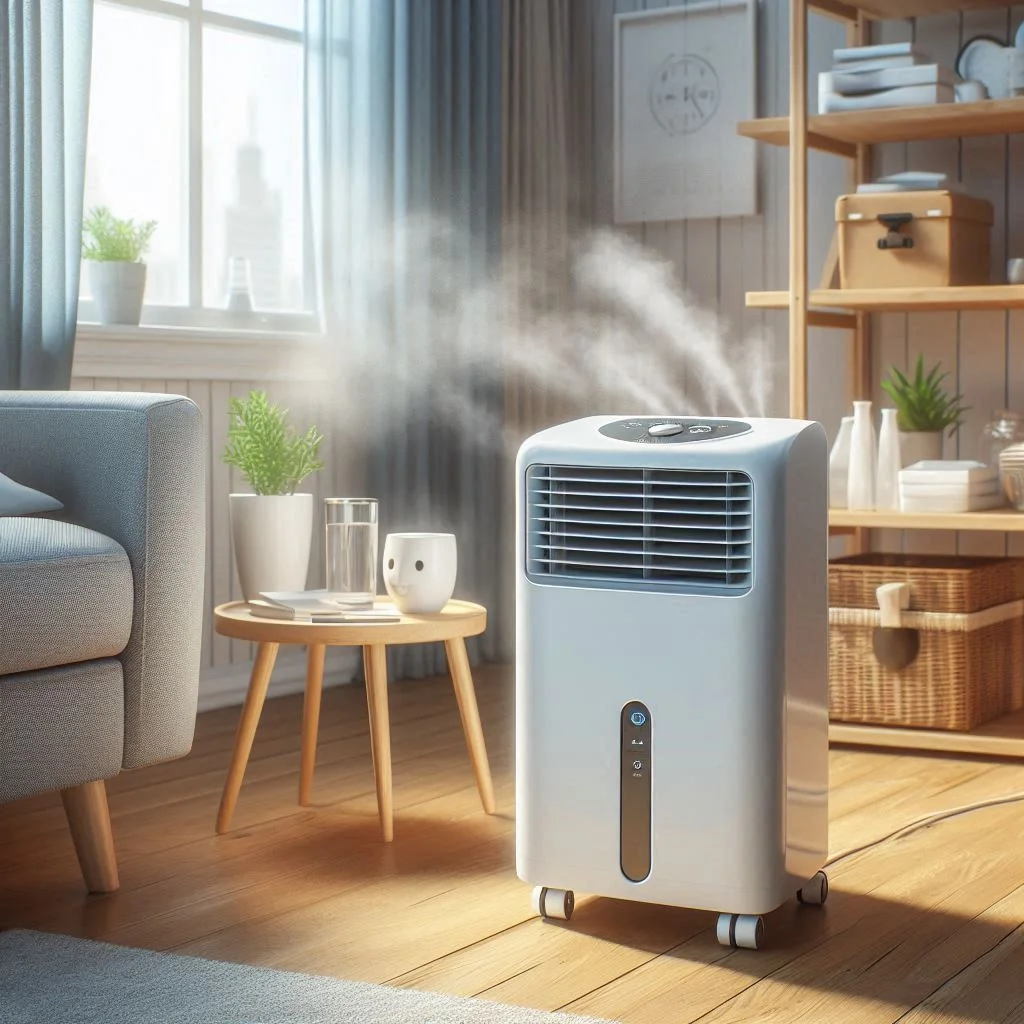
Q5: How do I prevent mold from growing in my window air conditioner?
Preventing mold growth requires regular maintenance and minimizing the factors that foster mold growth. Here are key preventive measures:
- Regular cleaning: Clean the filter and coils every 1-2 months to prevent mold buildup.
- Proper ventilation: Keep the AC unit well-ventilated and ensure that it is installed at a slight tilt to allow water to drain properly.
- Minimize moisture: Use a dehumidifier in humid environments and fix any leaks around the unit.
- Professional servicing: Have your AC unit serviced once a year by a professional technician to inspect for any mold or moisture buildup.
By maintaining these habits, you can keep your window air conditioner free from mold and ensure it functions efficiently.
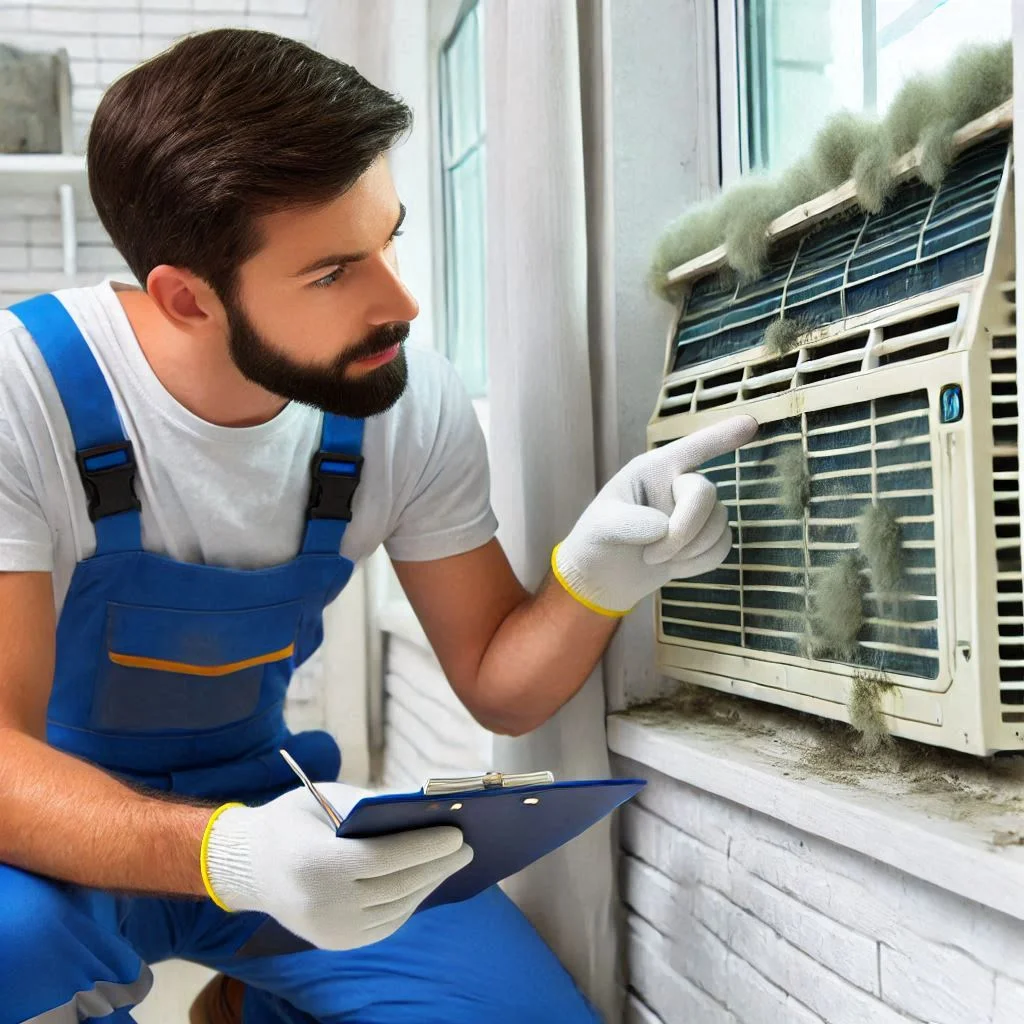
Conclusion
In conclusion, understanding how to clean and prevent mold in your window air conditioner is essential for maintaining a healthy indoor environment and ensuring your AC unit operates efficiently. By regularly cleaning the unit, ensuring proper ventilation, minimizing moisture, and using effective mold removal methods, you can significantly reduce the chances of mold buildup. Additionally, professional servicing and using tools like dehumidifiers and UV light purifiers can offer extra protection against mold growth. With these proactive steps, you’ll not only extend the life of your window air conditioner but also improve the air quality in your home. Regular care and maintenance will keep your AC running smoothly and mold-free, allowing you to enjoy clean, cool air without worry.

